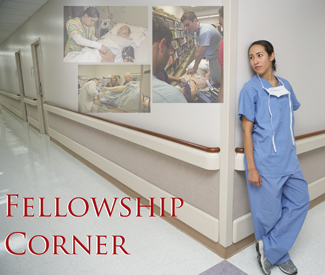Fellowship Corner: Bad jokes, good practice

By Adrienne Koch, M.Div. and Marame Gattan, M.D.
Inter-professional Advanced Fellows in Clinical Simulation 2016-2017
Durham VA Health Care System
DURHAM, N.C. – A physician and a chaplain walk into a patient’s room... This may sound to you like the beginning of a bad joke, but in our case, it’s the beginning of good practice. In 2012, a sociologist wrote for the Huffington Post on “Speaking Different Languages: Physicians and Chaplains in Health Care.[1]” The author “shadowed and interviewed physicians and chaplains at large academic hospitals learning how they see each other and work together.” She found that “while some physicians — especially those caring for severely-ill patients and their families — work regularly with chaplains, others do not know who the chaplains are or how to contact them.”
This was the case for Dr. Gattan, who received excellent medical training in both Saudi Arabia and the U.S., except none of it involved working with chaplains. It was not until she became an Advanced Simulation Fellow at the Durham VA Health Care System (HCS) that she began working closely with a chaplain for the first time.
Many physicians do not learn about the benefits of chaplaincy during the course of their training because many hospitals either has understaffed chaplaincy departments, relies on volunteers, or hires ministers who have not been certified through the Association for Clinical Pastoral Education (ACPE).
Though Clinical Pastoral Education (CPE) dates back to the 1920s, ACPE was not formed until the late 1960s. The process of psychology’s integration within the health care field took about 50 years from the time psychology was included in undergraduate curriculum in the 1920s to its recognition as an APA Division in the 1970s.[2] ACPE is celebrating its 50th anniversary this year. Compared to how long it took psychologists to be accepted as a viable member of the medical team, in some ways, simulation is still at the forefront of inter-professional collaboration, pairing physicians with chaplains.[3]
“There is still so much to explore in the relationship between chaplains, physicians and other health care providers,” said Mary E. Holtschneider, RN, MEd, Durham VA simulation fellowship co-director. “This is our second year having a chaplain Advanced Simulation Fellow on the team, and in both instances, we have learned a tremendous amount from them about the healing powers of ‘presence.’” Chan W. Park, MD, FAAEM, Durham VA simulation fellowship co-director, added, “Chaplains have significantly expanded our simulation offerings to go beyond traditional hands-on skills and clinical knowledge. They have added the extra dimension of focusing on emotional response and other holistic aspects that we have not traditionally explored.”
Chaplains of all traditions practice various disciplines in order to maintain a stance of present awareness of themselves, their communities and the divine. These practices allow chaplains to offer receptivity, compassion and spiritual healing to patients in ways that are sometimes counter-intuitive to physicians, who, by root-definition (physis) are the healers of things physical.
“In some ways, chaplains are the yin to the physician’s yang,” said Chaplain Koch, Dr. Gattan’s partner in the simulation fellowship. “The two seemingly contrary modes of the physician’s doing (yang) and the chaplain’s being (yin) can be complementary, interconnected and interdependent in the healthcare setting.”
Because signs of moral injury in Veterans often include spiritual concerns, Dr. Gattan and Chaplain Koch have found that increased awareness of moral injury is a clear path for inter-professional collaboration. One evening when Dr. Gattan was the attending physician in the Emergency Department, a patient came in with suicidal intention. Early in the discussion, she saw and heard clear signs of moral injury, including self-condemnation, self-harming ideation, shame and guilt. She called the chaplain to tend to the effects of moral injury and the psychiatrist to tend to the co-morbid signs of Post Traumatic Stress Disorder (PTSD).
Durham isn’t the only Advanced Simulation Fellowship site to have included chaplains into its inter-professional team. In 2015, the Pittsburgh VA also hired a chaplain Advanced Simulation Fellow. As the simulation education field continues to expand its reach to greater diversity of inter-professional learners and faculty, perhaps in the near future when a physician and chaplain walk into a patient’s room, it will no longer sound like the beginning of a bad joke, but simply be recognized as a crucial part of best practice.
[1] http://www.huffingtonpost.com/wendy-cadge/chaplains-health_b_1823522.html
[2]https://www.acpe.edu/pdf/History/ACPE%20Brief%20History.pdf
[3] http://www.ncbi.nlm.nih.gov/pmc/articles/PMC2902090/



















